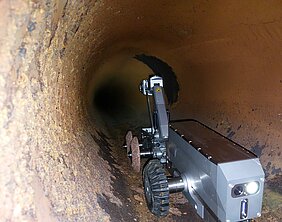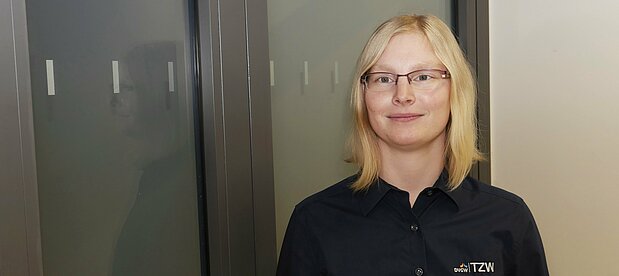Optical methods for pipe inspection are well established in the wastewater sector. In the hygienically relevant drinking water sector with pressure pipes and few access options, this potential has not been exploited so far. Last year, TZW carried out optical inspections in drinking water pipes of various types using a specially adapted remote-controlled crawler.
Context
In the OptInspekt project, which is funded by DVGW, the potential of optical and acoustic inspection of drinking water pipes for condition assessment is being investigated. Among other things, the aim is to evaluate the data collected during the inspection for the purpose of condition assessment. Within the framework of this research project, TZW was able to gather numerous practical experiences with the optical inspection of drinking water pipes last year.
The inspection system
The inspection system used by TZW is a commercially available and established crawler with a high-resolution pan and tilt camera, which is adapted to the special conditions of drinking water networks. In contrast to conventional crawlers, the crawler used is connected to the control unit via an optical fiber cable. Due to the lower weight of the cable, inspection lengths of up to 2,500 meters are possible with the system. This means that long stretches can be inspected even when access to the pipeline is limited.
The inspection schedule
Before an inspection can take place, it is always necessary to prepare the project carefully. The first step before an inspection is therefore to clarify the inspectability of the pipeline, which is significantly influenced by the layout of the pipeline and existing installations. In the next step, the risk and hygiene concept must be drawn up or adapted for the respective application. TZW has developed a hygiene concept for its operations, including disinfection of the operational system. A DVGW project group is currently preparing a leaflet to support water supply companies in planning and implementing inspection measures.
The practical application
TZW has already carried out a wide variety of investigations. Whether manhole or open excavation, whether PVC, ductile cast iron or steel, whether bitumen, cement mortar or uncoated pipeline: TZW is equipped for all areas. So far, pipelines of the dimensions 400 - 600 have been examined. This has involved both drained and partially filled pipes. Even a pipeline under pressure is no obstacle, as the system is pressure-stable up to 4 bar.
The results of the inspections
As a result of the various inspections, TZW compiles an overview of the anomalies that can be detected with an optical pipe inspection. At the end of the project, recommendations can be made as to which questions make optical inspection of a pipeline worthwhile. Examples include the question of the condition of the sacrificial anodes inside the pipeline or the condition of internal coatings.

![[Translate to English:] Prüfstelle-Produktprüfung_Teststand Test centre and product testing](/fileadmin/_processed_/0/9/csm_TZW-Karlsruhe_Pruefung_Geraete-Teststand_377188946c.jpg)

























